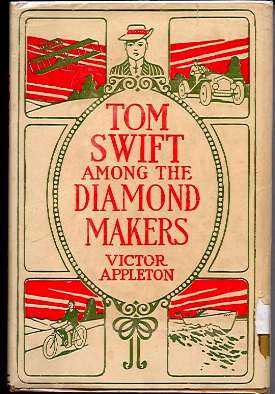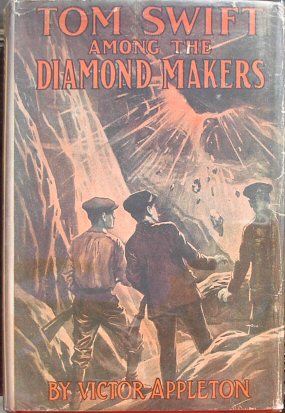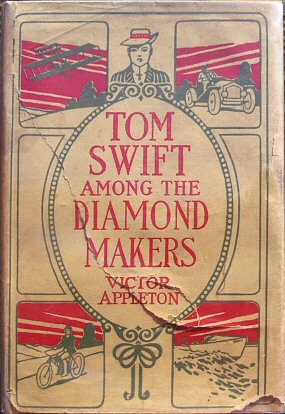
Tom Swift Among the Diamond Makers
Or, The Secret of Phantom Mountain
by Victor Appleton
White Quad, Brown Quad and Duotone images from the collection of Mark Snyder
Summary:
No official summary was ever provided with any of the old Tom Swift books. However, the plot can be summed up as follows:While young Tom Swift is in a jewelry store shopping for a ring for Mary, he meets a man who claims to be willing to teach Tom how to make diamonds. Later, the man (who happens to be one of the party that Tom rescued in the book Tom Swift and his Wireless Message) tells Tom his story -- how he was approached by a group of men who knew how to make diamonds, how he actually watched them make diamonds, and how he gave them some money, and how they dumped him (but not before giving him a fortune in diamonds). The man urges Tom to go with him on a hunt for these diamond makers.
After some thought on the matter, Tom agrees to go after the diamond makers, taking with him Ned, Mr. Damon, and Mr. Parker (the doomsday-predicting scientist in Tom Swift and his Wireless Message who predicted the destruction of the island). After a long search and plenty of adventures along the way, the small band locates the diamond makers -- but is then captured.
Can they escape from Phantom Mountain? Can they learn the secret of the diamond makers? Will the mountain really be destroyed, as Mr. Parker predicted? It's all there, in Tom Swift Among the Diamond Makers.
![]()
Major Inventions

Tom Swift didn't invent anything in this book. He did use some of the things he invented in the past (such as his Airship), but he didn't invent anything new. However, that's not to say that there isn't an intriguing scientific concept here, because there is one -- in the process of diamond making.
Basically, the diamond makers harnessed the power of lightning to create diamonds. They set up base in a mountain loaded with iron that attracted a great deal of lightning. When any storms would come along the lightning would strike the mountain, creating enormous currents of heat and pressure that the diamond makers used on their carbon-chemical and thus create their diamonds with.
The basic idea behind all of this -- that is, that diamonds can be made by applying tremendous amounts of heat and pressure -- is very scientific. Today's scientists do indeed have the ability to make diamonds. The process is enormously expensive and yields only minute small diamonds, but it can indeed be done. There is even some talk about "growing" very, very, very small diamonds in a special diamond dust type mixture and coating glass and other substances with a diamond coating.
However, it's completely impossible for us to make large, jewel-quality diamonds on an economic basis. If it were, we would no longer go through the enormously expensive and tedious process of mining diamonds ourselves; we would simply manufacture them instead. The idea set forth on the book is an intriguing one. Why not harness the enormous power of lightning? It is a well-known scientific fact that lightning packs enormous quantities of raw electrical power. Why not let lightning do our work for us?
 For that matter, why stop at using it to create diamonds? Why not set up pollution-free power stations to harness lightning to power cities? Lightning comes in vast quantities, is free, is enormously powerful, and does not deplete fossil fuels or the environment in any way. Why not tap this nearly unlimited natural resource of ours?
For that matter, why stop at using it to create diamonds? Why not set up pollution-free power stations to harness lightning to power cities? Lightning comes in vast quantities, is free, is enormously powerful, and does not deplete fossil fuels or the environment in any way. Why not tap this nearly unlimited natural resource of ours?
Simply because lightning is so powerful and uncontrollable. The idea is scientifically sound, but it is a bit unpractical. I haven't done any experiments to back this up with, but I'm reasonably sure that it would be a tremendous job to harness lightning. How could one possibly take a lightning bolt and purify it to the type of electricity you want? Maybe it could be done, but it would be an enormous job and would require years of work and research.
Still, it just might be worth it. Someone should look into this one of these days÷
Here are some passages extracted from the book that talk about diamond making:
÷The men were unaware of the presence of our friends, and were busily engaged. Some attended to the grinding machine, the roar and clatter of which made it possible for Tom and the others to talk and move about without being overheard. Into this machine certain ingredients were put, and they were then pulverized, and taken out in powdery form.
The power to run the mixing machine was a gasoline motor, which chug-chugged away in one corner of the cave.
As the powder was taken out, other men fashioned it into small balls, which were put on a pan, and into a sort of oven, that was heated by a gasoline stove.
"Is that how they make the diamonds?" asked Mr. Damon.
"That is evidently the first step," said Mr. Jenks. "Those balls of powdered chemicals are partly baked, and then they are put into the steel box. In some way terrific heat and pressure are applied, and the diamonds are made."
÷
Suddenly there rushed into the cave a man who seemed much excited.
"Are you nearly ready with that stuff?" he cried. "There's a good storm gathering on the mountain!"
"Yes, we'll be ready in half an hour," answered one of the men at the mixing machine.
"Good. It will be flashing lightning bolts then, and we can see what luck we have. The last batch was a failure." The man hurried out again.
÷
Eagerly the adventurers looked through the opening at the end of the passage into the larger cave. The men opened the small oven in which the balls of white chemicals and carbon mixed, had been baked, and a pile of things, that looked like irregularly shaped marbles, were placed in the steel box.
This box, which was about the size of a trunk, was of massive metal. It was placed in a recess in the solid rock, and all about were layers of asbestos and other substances that were non-conductors of heat.
÷
"But, bless my watch-charm!" exclaimed Mr. Damon, "I didn't know lightning made diamonds."
"It does not -- always," went on the scientist. "But great heat and pressure are necessary to create the gems. In nature this was probably obtained by prehistoric volcanic fires, and by the terrific pressure of immense rocks. It is possible to make diamonds in the laboratory of the chemist, but they are so minute as to be practically valueless."
"However, these men seem to have hit upon a new plan. They utilize the terrific heat of lightning, and the pressure that is instantaneously obtained when the bolt strikes. I am anxious to see how it is done. Look, I think they are getting ready to make the gems."
Indeed there seemed to be an air of expectancy among the diamond makers. The mixing machine had now been stopped, and, as it was quieter in the face, our friends, in their hiding-place, had to speak in mere whispers. All the men were now gathered about the great steel box.
This receptacle had been closed by a solid metal door, which was screwed and clamped tight. Then one of the men examined a number of heavily insulated electric wires that extended from the box off into the darkness where Tom and his companions could not discern them.
÷
 "Will the storm be severe enough?" asked one of the helpers. "We had all our work for nothing last time. The flashes weren't heavy enough."
"Will the storm be severe enough?" asked one of the helpers. "We had all our work for nothing last time. The flashes weren't heavy enough."
"These will be," asserted Folwell. "The indicator shows nearly a million volts now, and it's increasing."
"A million volts!" exclaimed Tom. "I hope it doesn't strike anywhere around here."
"Oh, it will probably be harmlessly conducted down on the heavy wire," said Mr. Parker. "We are in no danger, at present, though ultimately I expect to see the whole mountain shattered by a lightning bolt."
"Cheerful prospect," murmured Tom.
There was a terrific crash outside. The rocky floor of the cave trembled.
"Here she comes!" cried Folwell. "Get back, everybody! I'm going to throw over the switch now!"
The men retreated well away from the steel box. Folwell threw over the lever--the same one Mr. Jenks remembered pulling. Then the man ran to the electric switch on the wall, and snapped that into place, establishing a connection.
There was a moment's pause, as Folwell ran to join the others in their place of safety. Then from without there came a most nerve-racking and terrifying crash. It seemed as if the very mountain would be rent into fragments.
Watching with eager eyes, the adventurers saw sparks flash from the steel box. Instantly it became red hot, and then glowed white and incandescent. It was almost at the melting point.
Then came comparative quiet, as the echoes of the thunder died away amid the mountain peaks.
"I guess that did the trick!" cried Folwell. "It was a terrific crash all right!"
He and the others ran forward. The steel box was now a cherry red, for it was cooling. Folwell threw back the lever, and another man disconnected the switch. There was a period of waiting until the box was cool enough to open. Then the heavy door was swung back.
With a long iron rod Folwell drew something from the retort. It was the tray that had held the white balls. Bur they were white no longer, for they had been turned into diamonds. From their hiding-place Tom and the others could see the flashing gems, for, in spite of the fact the diamonds were uncut, some of them sparkled most brilliantly, due to the peculiar manner in which they were made.
÷
"That's going some!" exclaimed the chief of the diamond makers. "We have a small fortune here."
![]()
Tom Swift and His Wireless Message | Tom Swift in the Caves of Ice | Back to the Index